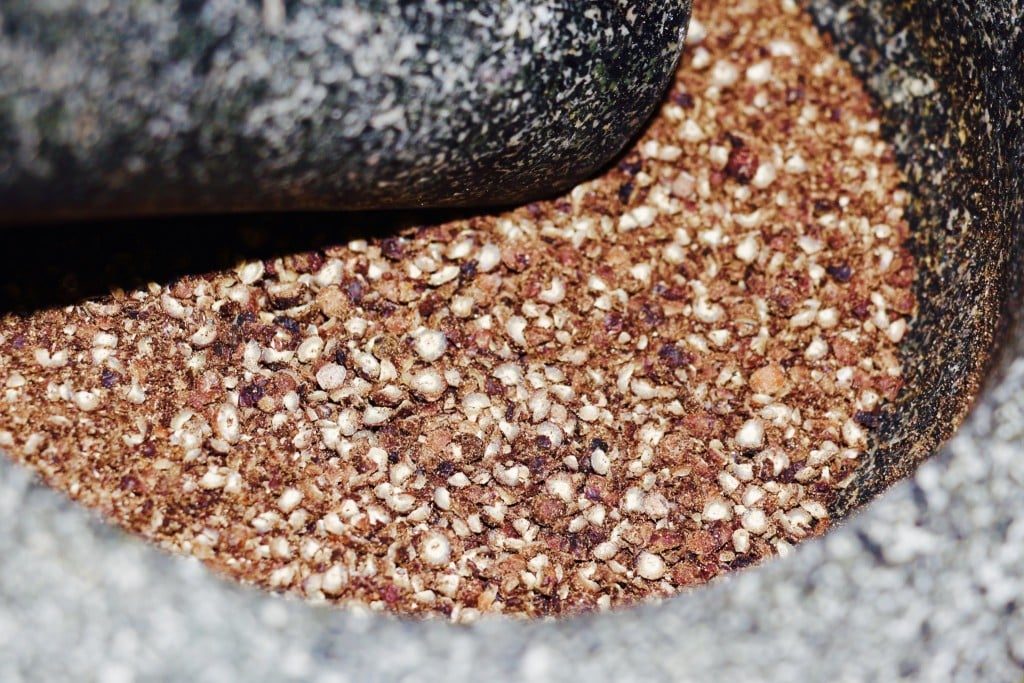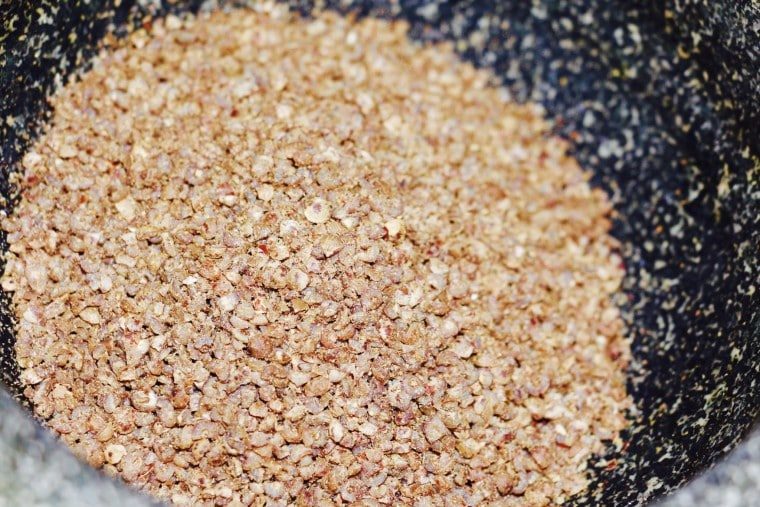Kampot Pepper from Cambodia: the best pepper in the world, in my humble opinion
Step right up, ladies and gentlemen, pepper enthusiasts, and culinary connoisseurs! Prepare to embark on a flavor-filled journey that will tingle your taste buds and ignite your imagination. Today, we unveil the captivating story of pepper that has captured the hearts and palates of cooks, gourmets, and spice aficionados alike. Let’s dive into the world of Kampot Pepper!
Table of Contents
So, what’s the deal with Kampot Pepper, you ask? Well, my friends, it’s no ordinary spice. Hailing from the exotic lands of Cambodia, this cultivar of black pepper, scientifically known as Piper nigrum, is a true gem that has stood the test of time. Dating back centuries, Kampot Pepper has been a secret weapon in the kitchens of Cambodian cooks, and the culinary elites of France, and even sparked the curiosity of spice enthusiasts from across the globe.

Here are the black peppercorns after I have hand-cracked them. The smell is incredible. The black Kampot Pepper from Cambodia has a unique aroma and heat taste, with the taste of citrus. It’s incredible, I still have a little burn on my tongue as I type, and that is about 10 minutes ago after tasting some.
Now, let’s take a quick detour to the past—picture this: the early 20th century, when Cambodia was under the French protectorate within French Indochina. Kampot Pepper, in all its glory, went by the name “Indochinese pepper” back then. But fear not, dear reader, its modern name pays homage to the enchanting Province of Kampot, where it has been lovingly grown and cultivated for generations.
Ah, but what makes this pepper so extraordinary, you may wonder? Well, dear reader, it’s all about the unique conditions in which it thrives. Nestled in the foothills of the Elephant Mountains, the climate of Kampot Province offers a perfect haven for pepper plants to flourish. But that’s not all—the quartz-rich soil adds its own touch of magic, contributing to what we call the “terroir” of Kampot pepper. Yes, you heard that right—this pepper has its very own terroir, just like fine wines!
Now, let’s address the burning question on your mind: “Why should I keep reading?” Well, my friend, Kampot Pepper is not just any pepper. It holds the prestigious title of a certified geographical indication (GI) product, both in Cambodia and the European Union. The small-leaf and big-leaf varieties offer a range of flavors and aromas that will take your culinary creations to new heights.
And let’s not forget the captivating history, from ancient Angkor to the Parisian restaurant scene, and the revival of this pepper cultivar after the dark times of the Khmer Rouge regime.
So, dear reader, if you’re ready to embark on a voyage of taste, history, and culinary delight, fasten your seatbelts and join us as we uncover the secrets of Kampot Pepper. Get ready to add a dash of enchantment to your dishes, a sprinkle of history to your kitchen, and a burst of flavor to your life. Trust us, this is one spice you don’t want to miss!
Stay tuned for the tantalizing tales and delectable recipes that await you in the world of Kampot Pepper. Your taste buds will thank you later!
ISLIFEARECIPE-dia time:
The cultivation of peppers in the Kampot region of Cambodia is a tradition that goes back for millennia. It truly is recognized Worldwide, and I have two tubs of it – weeeee. Peppercorns have been cultivated in Cambodia since the 13th century, but the industry really boomed under French colonial rule in the 19th and 20th centuries, when European chefs started appreciating Kampot pepper’s notably floral and slightly sweet flavor. The pepper’s most important characteristic is its tendency to linger on the tongue.
It takes the pepper vines three years to grow to production, and they can grow for twenty years if cared for accordingly. Growers use natural pesticides, so it’s organic folks. They also use cow manure and guano (bat poo) collected from caves nearby as natural manure. The vines are apparently very sensitive to the sun, so rather than slapping on some Factor 5, the growers lay rows and rows of dried palm branches to protect them.
So as you can see it is grown only using traditional methods and is then also hand-picked which awards it a Protected Geographical Indication (GI) status – this is the same status that others, such as Champagne, have attained. Nicely done Kampot, and nicely done beautiful Cambodia.
Ahead of an impending breakfast session tomorrow (watch for that recipe), I cracked the peppercorns myself by hand in my pestle and mortar – the only way to do it as far as I am concerned. And here is the resulting Kampot Pepper from Cambodia.

And here is the amazing-looking White Kampot Pepper, again just after I have cracked it – a completely different aroma to the black. The white pepper is rarer than the Kampot black pepper, is also less spicy, and has a very unique flavor and aroma. Did you know white peppercorns are simply black peppercorns with the skin removed, so they lose some heat? You can also get Red Kampot Pepper, which is great with fish dishes.
Our Conclusions of Kampot Pepper:
Experience the unparalleled flavors of Kampot Pepper, a prized cultivar of black pepper grown and produced in Cambodia. Known for its strong and delicate aromas, this exceptional spice offers a taste that ranges from intensely spicy to mildly sweet, with hints of eucalyptus and fresh mint.
Discover the rich history and strict regulations behind its cultivation, making it a sought-after ingredient for renowned chefs worldwide. Explore the unique qualities of Kampot Pepper and elevate your culinary creations with its exquisite flavor profile. Discover the true essence of this remarkable pepper and embark on a gastronomic journey unlike any other.
All I would say folks is that if you happen to be in Cambodia, get yourself some, Buy Kampot Pepper from Cambodia in bulk whilst there, because it is blood expensive when you get back home. I had a look on Amazon and for a very small pack, you would pay $16 USD. OUCH. Oh yeah, plus shipping. Get some yourself folks. It is stellar, every kitchen should have some. ENJOY!!!
Is Life a Recipe YouTube Channel
Frequently Asked Questions about Kampot Pepper:
Question: What’s special about Kampot pepper?
Unique Terroir: The climate and soil conditions in Kampot Province contribute to the distinctive characteristics of Kampot pepper. The warm and humid weather, combined with the quartz-rich soil in the foothills of the Dâmrei Mountains, create optimal farming conditions for peppercorn vines. The terroir of Kampot pepper gives it a superior flavor and aroma. Due to its exceptional quality and reputation, Kampot pepper has become highly sought after in the culinary world, and its protected status ensures its authenticity and integrity as a premium spice
Question: Why is Kampot pepper so expensive?
-
Limited Production: The pepper is cultivated in a small region in Cambodia, specifically the Kampot and Kep provinces. The production area is relatively small compared to other pepper-growing regions, resulting in limited supply. The restricted production capacity cannot meet the high demand, which drives up the price.
-
Labor-Intensive Cultivation: The cultivation involves labor-intensive processes. The pepper plants need to be hand-pollinated, and the peppercorns are harvested by hand. This manual labor increases production costs and contributes to the higher price of Kampot pepper.
-
Strict Quality Standards: The pepper has obtained a Protected Designation of Origin (PDO) certification, ensuring that only pepper is grown in the designated region and meeting specific quality standards can be labeled as Kampot pepper. Adherence to strict quality standards requires careful monitoring and control throughout the production process, adding to the overall cost.
Question: What does Kampot pepper taste like?
-
Floral Notes: The pepper offers floral notes, which add a delicate and aromatic aspect to its flavor. The floral undertones contribute to the complexity and uniqueness of Kampot pepper [1].
-
Citrus Hints: Alongside the floral notes, it has hints of citrus. This citrus aspect adds a bright and refreshing element to its flavor, further enhancing its overall taste [1].
-
Pungency: The pepper is known for its extraordinary pungency. It has a robust and bold spiciness that delivers a satisfying kick. The pungency of the pepper is notable and sets it apart from milder black pepper varieties.
-
Lingering Flavor: Another characteristic is its ability to linger on the tongue. The flavor stays with you for a longer duration compared to other black peppers.
Question: Is Kampot pepper hot?
The pepper is not typically considered hot in terms of spiciness. It is known for its complex flavor profile and aromatic qualities rather than intense heat.
Question: Where is Kampot pepper production in Cambodia?
Kampot pepper production in Cambodia is primarily located in the Province of Kampot, which is situated in southwestern Cambodia. The pepper is grown and produced in this region due to the favorable climate and soil conditions, particularly the quartz content in the soil found in the foothills of the Elephant Mountains, which contribute to the unique terroir of Kampot pepper.
It is a certified geographical indication (GI) product in Cambodia since 2010 and in the European Union since 2016. The production involves two varieties: the small leaf variety (known as “kamchay” in Khmer) and the big leaf variety (referred to as “lampong” or “belantoeung”).
Origins of Kampot Pepper:
Kampot Pepper is a type of black pepper that is cultivated and produced in Cambodia. It is known for its high quality and unique flavor profile, which has made it highly sought after by chefs and culinary enthusiasts around the world. Kampot Pepper is a cultivar of the plant species Piper nigrum, specifically, the variety known as ‘Kampot.’
The cultivation methodology has a long history in Cambodia, dating back to the 13th century. It gained recognition during the French colonial period in the early 20th century and was even referred to as “Indochinese pepper.” The pepper is grown in the Kampot and Kep provinces of Cambodia, where the combination of the region’s climate, soil, and traditional farming methods contribute to its distinct characteristics.
This infamous pepper is known for its strong and delicate aroma, and its taste can range from intensely spicy to mildly sweet, with hints of floral and eucalyptus notes. The flavor profile is influenced by factors such as the terroir of the region and the careful harvesting and processing techniques employed by the farmers.
The unique qualities and reputation of this pepper have led to its recognition as a Protected Geographical Indication (PGI) by the European Union. This designation ensures that only pepper produced in the designated region of Cambodia can be labeled as Kampot Pepper, similar to the protection given to products like Champagne or Parmigiano-Reggiano.
ISLIFEARECIPE.net: FIVE recipes using incredible Kampot Pepper
Black Pepper Beef: Best Recipe 2023
ChillaxBBQ cook Chef Pynt’s dry-aged David Blackmore Wagyu
Incredible Skirt Steak: 10-Minute Recipe
Butter Bacon Prawns: Incredible Recipe (2023)
BBQ Prawns, Green Mango, Chili, Lime, and Mint Salad Recipe




